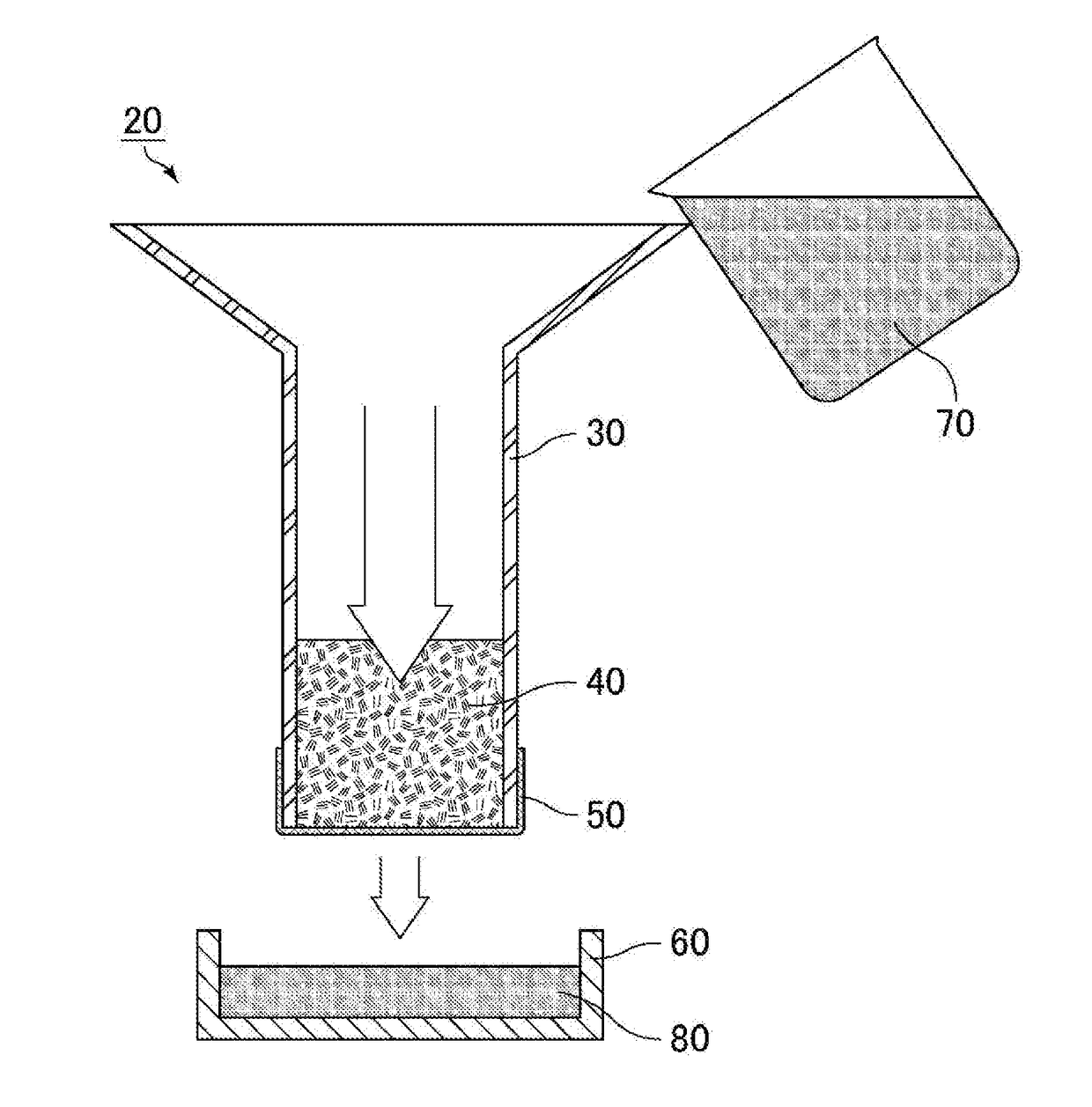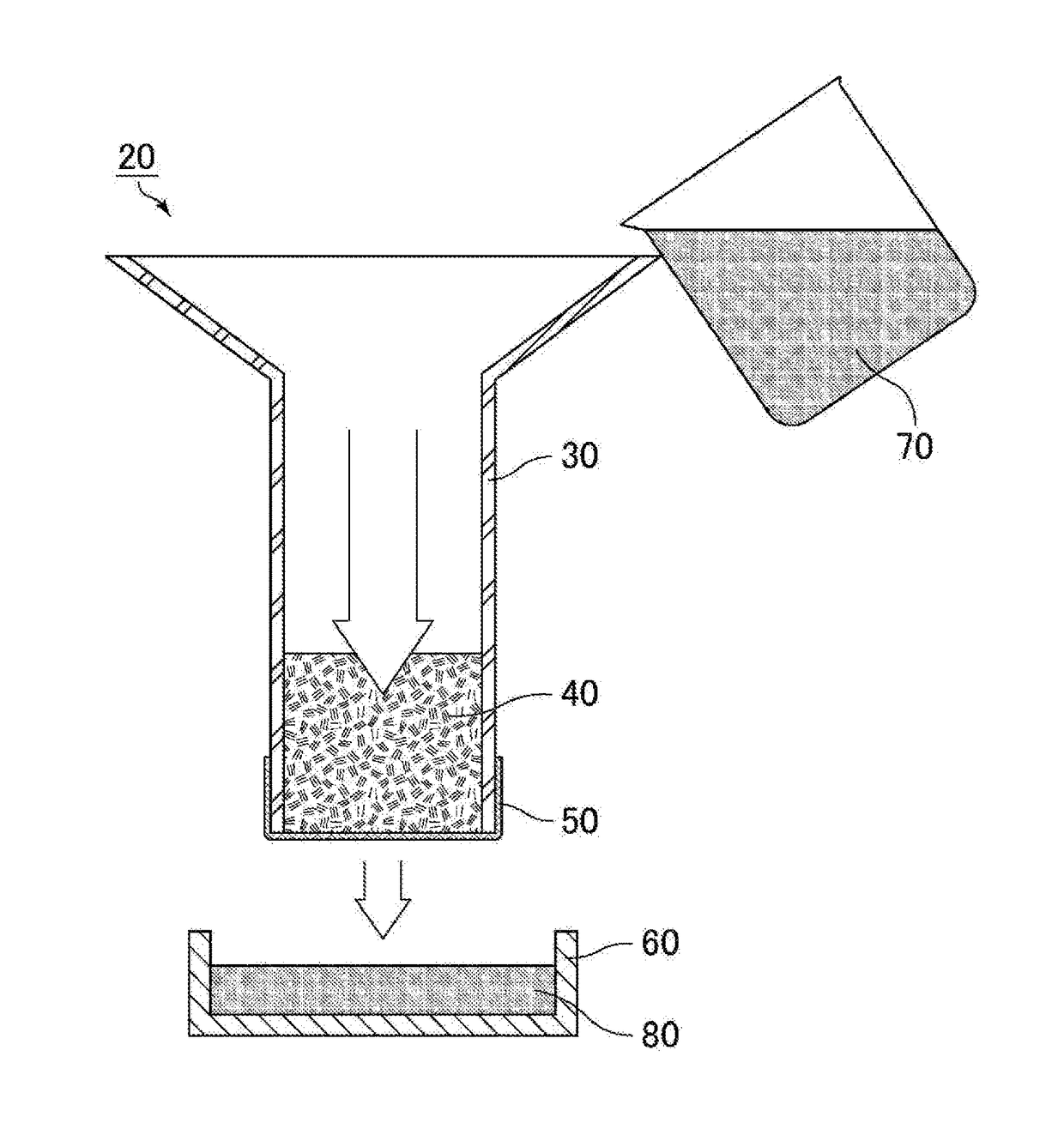Method of producing dielectric material
a dielectric material and dielectric technology, applied in the direction of fixed capacitors, thin/thick film capacitors, silicon organic compounds, etc., can solve the problems of deterioration of the dispersed dielectric material grains of a product, difficult to keep the cost of production low, and large grains becoming more likely to be generated, so as to achieve high reliability, low scattering of withstand voltage properties, and high dispersion
- Summary
- Abstract
- Description
- Claims
- Application Information
AI Technical Summary
Benefits of technology
Problems solved by technology
Method used
Image
Examples
first exemplary embodiment (
1. First Exemplary Embodiment (Method of Producing Dielectric Material Using Alkoxysilane as Organic Silicon Compound)
[0058]In a first exemplary embodiment, a method of producing a dielectric material in the case of using an alkoxysilane as an organic silicon compound will be described.
[0059](1) Preparation Step of Preparing Slurry
[0060]First, a slurry is prepared by mixing dielectric powder, water, one of an organic-acid metal salt and an inorganic metal salt, and alkoxysilane.
[0061]Powder of a perovskite-type compound including Ba and Ti is preferable as the dielectric powder. Specific examples of the perovskite-type compound include perovskite-type compounds represented by a general formula ABO3 (A sites correspond to Ba and may include at least one selected from a group consisting of Sr and Ca in addition to Ba; B sites correspond to Ti and may include at least one selected from a group consisting of Zr and Hf in addition to Ti; and O corresponds to oxygen).
[0062]In addition, pr...
second exemplary embodiment (
2. Second Exemplary Embodiment (Method of Producing Dielectric Material Using Water-Soluble Silane Coupling Agent as Organic Silicon Compound)
[0115]Next, as a second exemplary embodiment, a method of producing a dielectric material in the case of using a water-soluble silane coupling agent as an organic silicon compound will be described. Whereas an alkoxysilane is used as the organic silicon compound in the first exemplary embodiment, in the second exemplary embodiment, contrary to the first exemplary embodiment, a water-soluble silane coupling agent is used as the organic silicon compound.
[0116](1) Preparation Step of Preparing Slurry
[0117]First, a slurry is prepared by mixing dielectric powder, water, one of an organic-acid metal salt and an inorganic metal salt, and a water-soluble silane coupling agent.
[0118]Since the dielectric powder, water, and one of organic-acid metal salt and inorganic metal salt that are used have been described in the first exemplary embodiment, the des...
example 1
[0149]In 300 g of water, 1.76 g of dysprosium acetate and 0.53 g of manganese acetate were added, mixed and stirred, and thus an aqueous solution in which dysprosium acetate and manganese acetate were dissolved in water was prepared. To this, 100 g of grains of barium titanate (hereinafter referred to as BT grains) having an average grain diameter of 150 nm were added, and thus a slurry was prepared. To the prepared slurry, 2.1 g of 3-aminopropyltrimethoxysilane was added, stirring was performed for 30 minutes, and thus a slurry was prepared.
[0150]Next, an anion removing apparatus 20 as illustrated in the FIGURE was prepared.
[0151]That is, one end of a plastic cylinder 30 was covered by a mesh 50 to prevent an anion exchange resin from falling off, and then 200 ml of an anion exchange resin 40 (DIAION (registered trademark) SA10A-OH type available from Mitsubishi Chemical Corporation) was injected.
[0152]Next, a prepared slurry 70 was injected in the anion removing apparatus 20 prepa...
PUM
| Property | Measurement | Unit |
|---|---|---|
| temperature | aaaaa | aaaaa |
| temperature | aaaaa | aaaaa |
| particle diameter | aaaaa | aaaaa |
Abstract
Description
Claims
Application Information
 Login to View More
Login to View More - R&D
- Intellectual Property
- Life Sciences
- Materials
- Tech Scout
- Unparalleled Data Quality
- Higher Quality Content
- 60% Fewer Hallucinations
Browse by: Latest US Patents, China's latest patents, Technical Efficacy Thesaurus, Application Domain, Technology Topic, Popular Technical Reports.
© 2025 PatSnap. All rights reserved.Legal|Privacy policy|Modern Slavery Act Transparency Statement|Sitemap|About US| Contact US: help@patsnap.com



